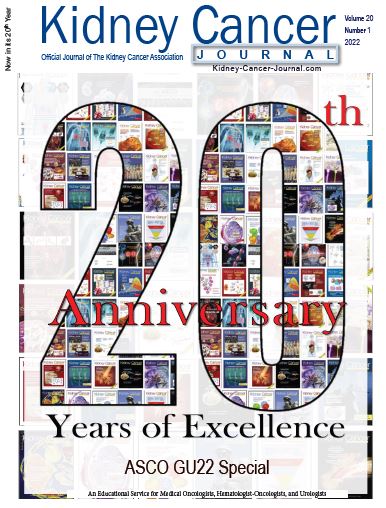20th Anniversay Special
https://doi.org/10.52733/KCJ20n1-e
20th Anniversary Issue of The Kidney Cancer Journal:
Reflecting on the Past, Celebrating the Present and Shaping the Future
Cedars Cinai Cancer Center, Los Angeles, CA
Correspondence to: Email: robert.figlin@cshs.org

Dear Colleagues,
It is with a great deal of pride that we celebrate the 20th Anniversary of The Kidney Cancer Journal and its continuing success as a renowned publication in the field of kidney cancers. The Kidney Cancer Journal published its first issue in 2003, and during the last two decades, it has grown rapidly in content, audience reach, and status. The journal's 20th anniversary, therefore, deserves a review of the journey that we've been through, as well as a look into its future. It seems appropriate to use this editorial to reflect upon these achievements – including the contribution that the Kidney Cancer Journal has made to the evolution of research within the discipline and awareness.When the Kidney Cancer Journal was launched in 2003, the spectrum of therapy for renal cell carcinoma was extremely limited and unimpressive. However, within a few years, the approval of new targeted therapies such as sorafenib, sunitinib, everolimus, bevacizumab, cabozantinib, pazopanib, axitinib, nivolumab, pembrolizumab and ipilimumab has tremendously transformed the landscape. As rapidly as the paradigm shifted, so did the rationale for sequencing and combining these treatments and optimization of dosing strategies. In recent years, the therapeutic landscape has continuously evolved with the utility of novel PD-1 or PD-L1 inhibitors. Most recently, combination doublet/triplet regimens comprised of IO/IO, IO/TKI, or other targeted agents gaining momentum in evolving RCC landscape. However, the quest still remains to identify alternative class pathways, for example, hypoxia-inducible factor inhibitors or metabolic pathways for those subpopulations that do not optimally benefit from current therapies.
During these 20 years, the editorial contents published in the KCJ have been serving, at least in part, as a touchstone for significant milestones in the evolution of strategies and reflected the most dramatic advances ever achieved in managing RCC. Aside from the manuscript or other research contents, KCJ has been providing conference coverages that offered tantalizing previews of clinical breakthroughs and practice-changing research updates presented at international conferences. Recently, KCJ has expanded its digital publishing tools such as eBlast, eNewsletter, webinars, podcasts, and social media to reach out to large global audiences.
As we celebrate 20 years of the journal and at the same time look forward, I, on behalf of the KCJ team, would like to acknowledge and appreciate all those colleagues and researchers who have made tremendous contributions to our journal over these years. I think that continuity in editorial policy alongside high editorial standards has played a substantial part in shaping the contribution that the Kidney Cancer Journal made to the field. Obviously, we wouldn’t be anywhere today without the past and present advisory board members, editors, including founding executive editor/publisher Stuart Chapman and William “Bill” Bro, who served the KCA board of directors. Also, I would like to pay special tribute to authors and colleagues for entrusting us with their discoveries and peer-reviewers for their insightful, thoughtful, and scholarly evaluation of our manuscripts. I extend my sincere appreciation to the Kidney Cancer Association as our pillar of support through the two-decade-long journey and moving forward as well. We are proud to be a Free- Access journal without any submission/processing/ publication charges for the manuscripts submitted. We will continue to pursue and publish the top-quality research articles and useful clinical resources possible, and we will continue to develop creative contents to disseminate latest research information efficiently and effectively to our readers across the globe and cancer communities as well.


